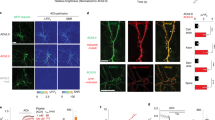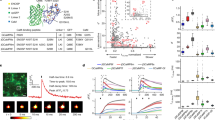Abstract
Neurons, sensory cells and endocrine cells secrete neurotransmitters and hormones to communicate with other cells and to coordinate organ and system function. Validation that a substance is used as an extracellular signaling molecule by a given cell requires a direct demonstration of its secretion. In this protocol we describe the use of biosensor cells to detect neurotransmitter release from endocrine cells in real-time. Chinese hamster ovary cells expressing the muscarinic acetylcholine (ACh) receptor M3 were used as ACh biosensors to record ACh release from human pancreatic islets. We show how ACh biosensors loaded with the Ca2+ indicator Fura-2 and pressed against isolated human pancreatic islets allow the detection of ACh release. The biosensor approach is simple; the Ca2+ signal generated in the biosensor cell reflects the presence (release) of a neurotransmitter. The technique is versatile because biosensor cells expressing a variety of receptors can be used in many applications. The protocol takes ∼3 h.
This is a preview of subscription content, access via your institution
Access options
Subscribe to this journal
Receive 12 print issues and online access
$259.00 per year
only $21.58 per issue
Buy this article
- Purchase on Springer Link
- Instant access to full article PDF
Prices may be subject to local taxes which are calculated during checkout





Similar content being viewed by others
References
Purves, D. et al. Neuroscience 88–91 (Sinauer Associates, 2008).
Jacques-Silva, M. et al. ATP-gated P2X(3) receptors constitute a positive autocrine signal for insulin release in the human pancreatic beta cell. Proc. Natl. Acad. Sci. USA 107, 6465–6470 (2010).
Rodriguez-Diaz, R. et al. Alpha cells secrete acetylcholine as a non-neuronal paracrine signal priming beta cell function in humans. Nat. Med. 17, 888–892 (2011).
Hayashi, M. et al. Vesicular inhibitory amino acid transporter is present in glucagon-containing secretory granules in alphaTC6 cells, mouse clonal alpha-cells, and alpha-cells of islets of Langerhans. Diabetes 52, 2066–2074 (2003).
Kim, H. et al. Serotonin regulates pancreatic beta cell mass during pregnancy. Nat. Med. 16, 804–808 (2010).
Cabrera, O. et al. Automated, high-throughput assays for evaluation of human pancreatic islet function. Cell Transplant. 16, 1039–1048 (2008).
Perry, M., Li, Q. & Kennedy, R.T. Review of recent advances in analytical techniques for the determination of neurotransmitters. Anal. Chim. Acta 653, 1–22 (2009).
Huang, Y. et al. Mouse taste buds use serotonin as a neurotransmitter. J. Neurosci. 25, 843–847 (2005).
MacDonald, P.E., Braun, M., Galvanovskis, J. & Rorsman, P. Release of small transmitters through kiss-and-run fusion pores in rat pancreatic beta cells. Cell Metab. 4, 283–290 (2006).
Huang, Y.A., Maruyama, Y. & Roper, S.D. Norepinephrine is coreleased with serotonin in mouse taste buds. J. Neurosci. 28, 13088–13093 (2008).
Tachibana, M. & Okada, T. Release of endogenous excitatory amino acids from ON-type bipolar cells isolated from the goldfish retina. J. Neurosci. 11, 2199–2208 (1991).
Kataoka, Y. & Ohmori, H. Of known neurotransmitters, glutamate is the most likely to be released from chick cochlear hair cells. J. Neurophysiol. 76, 1870–1879 (1996).
Braun, M. et al. Regulated exocytosis of GABA-containing synaptic-like microvesicles in pancreatic beta-cells. J. Gen. Physiol. 123, 191–204 (2004).
Braun, M. et al. Corelease and differential exit via the fusion pore of GABA, serotonin, and ATP from LDCV in rat pancreatic beta cells. J. Gen. Physiol. 129, 221–231 (2007).
Obermüller, S. et al. Selective nucleotide-release from dense-core granules in insulin-secreting cells. J. Cell Sci. 118, 4271–4282 (2005).
Hollins, B. & Ikeda, S.R. Heterologous expression of a P2x-purinoceptor in rat chromaffin cells detects vesicular ATP release. J. Neurophysiol. 78, 3069–3076 (1997).
Whim, M.D. & Moss, G.W. A novel technique that measures peptide secretion on a millisecond timescale reveals rapid changes in release. Neuron 30, 37–50 (2001).
Cabrera, O. et al. Glutamate is a positive autocrine signal for glucagon release. Cell Metab. 7, 545–554 (2008).
Rubí, B. et al. Dopamine D2-like receptors are expressed in pancreatic beta cells and mediate inhibition of insulin secretion. J. Biol. Chem. 280, 36824–36832 (2005).
Huang, Y.A., Dando, R. & Roper, S.D. Autocrine and paracrine roles for ATP and serotonin in mouse taste buds. J. Neurosci. 29, 13909–13918 (2009).
Huang, Y.A., Pereira, E. & Roper, S.D. Acid stimulation (sour taste) elicits GABA and serotonin release from mouse taste cells. PLoS ONE 6, e25471 (2011).
Nguyen, Q.T. et al. An in vivo biosensor for neurotransmitter release and in situ receptor activity. Nat. Neurosci. 13, 127–132 (2010).
Speier, S. et al. Noninvasive high-resolution in vivo imaging of cell biology in the anterior chamber of the mouse eye. Nat. Protoc. 3, 1278–1286 (2008).
Speier, S. et al. Noninvasive in vivo imaging of pancreatic islet cell biology. Nat. Med. 14, 574–578 (2008).
Karlsson, S., Myrsén, U., Nieuwenhuizen, A., Sundler, F. & Ahrén, B. Presynaptic sympathetic mechanism in the insulinostatic effect of epinephrine in mouse pancreatic islets. Am. J. Physiol. 272, R1371–R1378 (1997).
Huang, Y.J. et al. The role of pannexin 1 hemichannels in ATP release and cell-cell communication in mouse taste buds. Proc. Natl. Acad. Sci. USA 104, 6436–6441 (2007).
Acknowledgements
This work was funded by the Diabetes Research Institute Foundation (DRIF); US National Institutes of Health grants R56DK084321 (A.C.), R01DK084321 (A.C.), R01DC000374 (S.D.R.) and R01DC007630 (S.D.R.); the Juvenile Diabetes Research Foundation; the Swedish Research Council; the Novo Nordisk Foundation; the Swedish Diabetes Association, the Stichting af Jochnick Foundation and The Erling-Persson Family Foundation; and the World Class University program through the National Research Foundation of Korea funded by the Ministry of Education, Science and Technology (R31-2008-000-10105-0).
Author information
Authors and Affiliations
Contributions
R.D. and Y.A.H. performed experiments with biosensor cells to detect acetylcholine secretion; R.D., R.R.-D. and A.C. analyzed and quantified data; R.R.-D., R.D., P.-O.B., S.D.R. and A.C. designed the study and wrote the paper. All authors discussed the results and commented on the manuscript.
Corresponding authors
Ethics declarations
Competing interests
The authors declare no competing financial interests.
Rights and permissions
About this article
Cite this article
Rodriguez-Diaz, R., Dando, R., Huang, Y. et al. Real-time detection of acetylcholine release from the human endocrine pancreas. Nat Protoc 7, 1015–1023 (2012). https://doi.org/10.1038/nprot.2012.040
Published:
Issue Date:
DOI: https://doi.org/10.1038/nprot.2012.040
This article is cited by
-
Alpha cell regulation of beta cell function
Diabetologia (2020)
-
Mechanism and effects of pulsatile GABA secretion from cytosolic pools in the human beta cell
Nature Metabolism (2019)
-
An excessive increase in glutamate contributes to glucose-toxicity in β-cells via activation of pancreatic NMDA receptors in rodent diabetes
Scientific Reports (2017)
-
Characterization of pancreatic NMDA receptors as possible drug targets for diabetes treatment
Nature Medicine (2015)
Comments
By submitting a comment you agree to abide by our Terms and Community Guidelines. If you find something abusive or that does not comply with our terms or guidelines please flag it as inappropriate.



